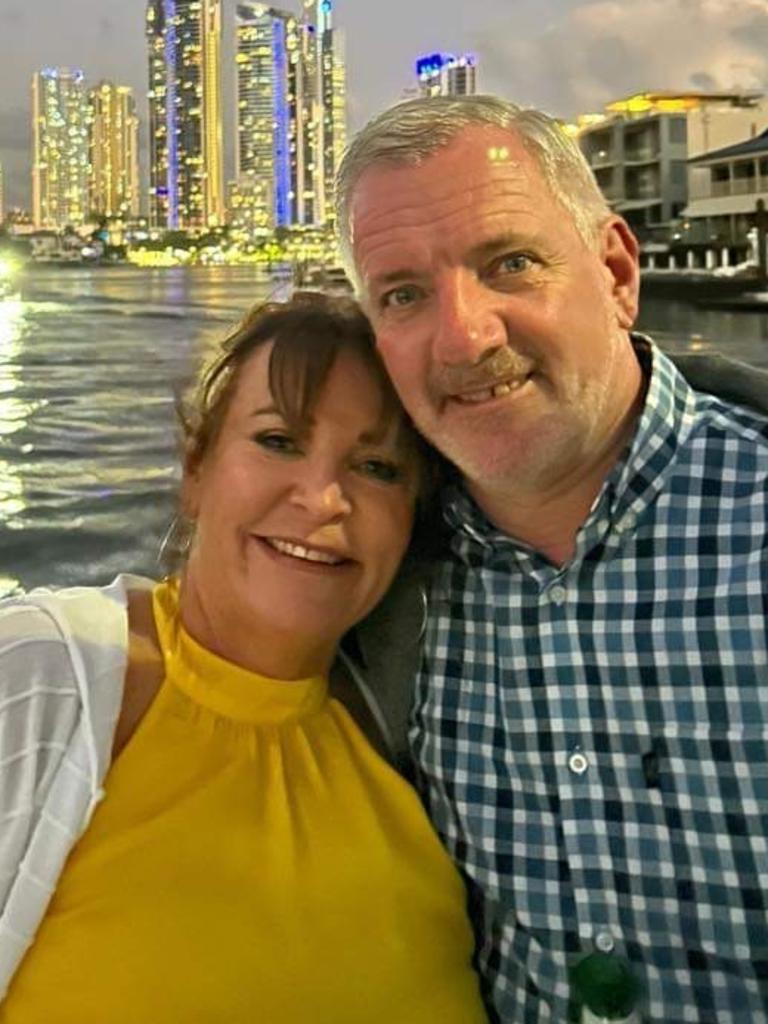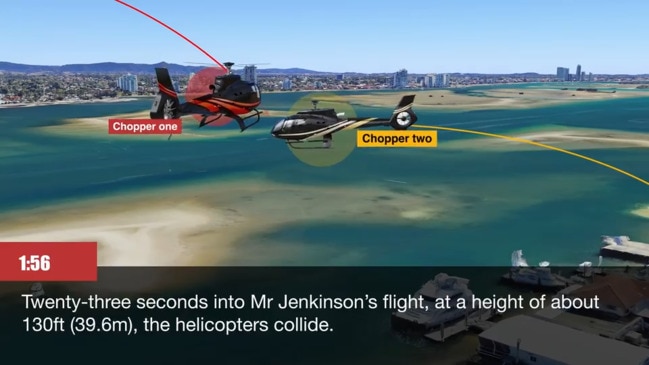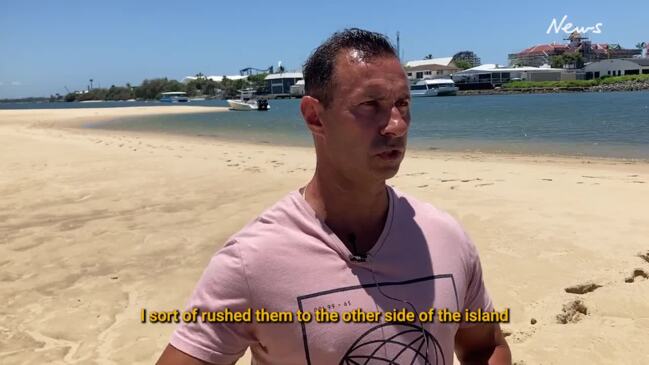‘Compounding series of failures’ led to deadly Sea World Helicopters crash
Faulty radio equipment, flawed safety systems and a raft of other issues contributed to the tragic Sea World Helicopters disaster which left four people dead, a safety investigation has found.

QLD News
Don't miss out on the headlines from QLD News. Followed categories will be added to My News.
An investigation into the Sea World Helicopters disaster has found the radio system on-board one of the choppers that crashed, killing four people, was defective, and it was likely the pilot made an announcement moments before impact which was subject to transmission failure.
It also found the cockpit of a new-model chopper that had only been in use for a week, and even a pilot’s cap, could have impeded their vision.
In the 200-page report handed down by the Australian Transport Safety Bureau on Wednesday, investigators found the radio system in the chopper in which Ash Jenkinson and three passengers died had defects that limited transmission range and affected reliability of transmission.
Investigators found it was likely Mr Jenkinson made a taxi call, but the transmission was never received by incoming pilot Michael James.
Without hearing a radio call, investigators reasoned Mr James had no trigger to reassess the status of VH-XKQ (the chopper piloted by Mr Jenkinson) as a “collision risk”.
The crash, on January 2, 2023, claimed the lives of Sea World Helicopters chief pilot Ash Jenkinson, British newlyweds Ron and Diane Hughes and Sydney woman Vanessa Tadros.


Other passengers including Mrs Tadros’ 10-year-old son Nicholas and Victorian woman Winnie de Silva and her nine-year-old son Leon were seriously injured.
The report found multiple failings, including that Sea World Helicopters knew of the risk of a midair collision and assumed that any “conflicting traffic” would always be visible to pilots.
“Furthermore, the operator did not deem the collision risk to be unusual and considered its existing baseline controls to be effective,” the report found.
It also found that separation between the two choppers relied solely on the pilots using a “see and avoid” approach.
The report found that in accordance with Sea World Helicopters’ procedures, the ground crew member gave the thumbs-up to Mr Jenkinson and then stopped monitoring the water and airspace.
It found the radio system on Mr Jenkinson’s chopper had defects that affected the reliability of transmissions.
“It is almost certain that a taxi call was not successfully broadcast from (Mr Jenkinson’s helicopter),” the report found.
“It is likely that the pilot made a taxi call, and that it was subject to a transmission failure.”
The report found Mr Jenkinson’s ability to identify Mr James’ aircraft over the Broadwater was limited due to restrictions on manoeuvring and visibility.
“Having to rely solely on unalerted see-and-avoid for separation, (Mr Jenkinson) almost certainly did not sight (Mr James’ helicopter) or manoeuvre to do so,” the report said.
Air crash investigators found a cap worn by Mr Jenkinson, along with the cockpit structure, may have obscured his vision of the other chopper.
They found that the pilots’ view of the Broadwater was “demonstrably more restricted” in the Eurocopter 130 helicopters, which the company had switched to only a week earlier after previously using AS350 Squirrels.
EC130 and AS350 pilots sit on the left and right hand side respectively in the aircraft and the report found that if Mr Jenkinson had been sitting on the right, he would have been more likely to have seen Mr James’ aircraft.
The report also raised multiple safety concerns including concerns over the standard inbound call made by pilots of helicopters preparing to land as they approached the nearby Porpoise Point as it was “not a reliable alert for a pilot on the ground while boarding and interacting with passengers”.
“A pilot on the ground would highly likely be focused on cabin preparation at the time of the inbound call,” the report said.
There were also concerns Sea World Helicopters procedures did not require ground crew to monitor airspace up to the time of the helicopter departing the helipad and reopening a helipad in March 2022 created an “increased risk of collision” with traffic operating from the existing heliport as there was a higher workload for both pilots and it was less likely that an inbound pilot would notice a change in status of a helicopter on the ground.
The report said helicopters would close on each other vertically and laterally, decreasing the likelihood of detection.
The ATSB report found changes to the operations of Sea World Helicopters designed to “improve its product offering.. brought unintended consequences” which contributed to the tragedy.
“These changes undermined risk controls,” the report revealed.
“The operator’s safety management system did not effectively manage aviation safety risk and change management was incomplete or absent.”

ATSB chief commissioner Angus Mitchell said the third, and final report into the helicopter collision had revealed 28 findings.
Mr Mitchell said the accident had occurred just a week after the two helicopters which were involved in the incident, had been introduced.
Mr Mitchell said the investigation had revealed that “a series of compounding risk failures (had) led to a catastrophic outcome”.
He said the new aircraft did not have the same safety features as the ones they had replaced.
He said a call from the incoming pilot, Ash Jenkinson, was not registered by the outgoing pilot, Michael James, just two minutes before the crash.
He confirmed faults were found in the radio antennae of one of the helicopters.
Mr Mitchell said numerous factors led to the crash.
“A number of holes lined up for this to occur,” he said.
“It should never be vulnerable to a single point of failure, such as a faulty radio or the pilot’s ability to detect another aircraft in the sky.
“This report also details safety actions subsequently taken by the operator in response to the accident.
“I do commend them for that however while acknowledging them, four issues are yet to be adequately addressed.
“This now forms the basis of formal recommendations to the operator.”
Mr Mitchell described it as a “compounding series of risk failures”.
“All incidents are preventable,” he said.
“A number of things failed which lined up and unfortunately that is the case with every aviation accident we investigate.
“These things do not just happen out of the blue.
“Certainly, the line of all of those failings led to a catastrophic outcome.
“Each individual failing was only one part; you need to put all of them together for this outcome to have occurred – and the outcome couldn’t have been worse.”
Mr Mitchell said transmission issues such as antenna faults were in place for a number of days but it was unclear whether they had been detected before the crash.
“Each individual fault was just one part. You need to put all parts together and the outcome couldn’t have been worse.”
Mr Mitchell said no blame was apportioned in the report and there would be a coronial inquiry into it in the future.


“There have been extensive undertakings by the company to look at the risks from this incident,” he said.
“A lot of the holes we found that lined up on January 2, 2023 have been fixed but we believe there is more work looking into the future.
“Changes must be carefully considered.”
Mr Mitchell said the scenario which occurred on January 2 would not occur today as a result of the changes made by Sea World Helicopters.
Mr Mitchell said he understood the report would be difficult reading for victims, their families and all those impacted by the event.
“We have gone to great lengths to understand what occurred and what can be done in the future to prevent it,” he said.
“This is not likely to provide closure to those who lost a loved one to those who lost a loved one, it is about improving aviation tourism in Australia.”


Shine Lawyers litigation specialist Roger Singh, whose firm is acting for a number of victims, said the tragedy was completely avoidable and had a devastating impact on so many lives.
“I would like to express my deepest sympathies to those who lost loved ones, and to those
whose injuries are now a permanent reminder of that ill-fated flight,” he said.
“I can confirm Shine Lawyers has filed a number of claims in the Supreme Court of Queensland on behalf of several people who were injured on board one of the helicopters, as well as others who were indelibly traumatised by what they witnessed on that day.
“These claims have been filed against Sea World Helicopters Pty Ltd.
“The claims for the passengers of the helicopter have been filed under the Civil Aviation (Carriers Liability) Act which caps damages at $925,000 per claimant.

“We will examine the findings of this report with a view to identifying other potential defendants and further damages which may be sought.
“No amount of money will give back what was taken from the victims of this crash, however we will ensure those responsible are held to account to the fullest extent.
“This was such a profoundly unnecessary loss of life.”
Mr Singh said the litigation was ongoing and he was doing all he could to expedite the process.
“I think it’s important for Sea World Helicopters and their lawyers to now come to the party and resolve these claims as quickly as possible,” he said.
Mr Singh would not reveal the number of clients or claims he was representing due to client confidentiality.
“We will be reviewing the report very carefully just to be more clear on the exact failings and whether other defendants can be identified against whom claims might be brought and further damages might be sought,” he said.
Originally published as ‘Compounding series of failures’ led to deadly Sea World Helicopters crash



